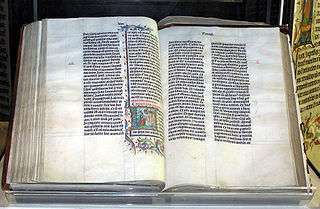Jewish apocrypha
The Jewish apocrypha, known in Hebrew as הספרים החיצונים (Sefarim Hachizonim: "the outer books"), are books written in large part by Jews, especially during the Second Temple period, and were not accepted as sacred manuscripts (canonical) when the Torah was fully canonized. Some of these books are considered sacred by some Christians, and are included in the Old Testament. The Jewish apocrypha is distinctive from the Christian Apocrypha and biblical apocrypha as it is the only one of these collections which works within a Jewish theological framework. [1]
| Part of a series on the |
| Bible |
|---|
 |
|
Perspectives |
|
Outline of Bible-related topics |
Apocrypha in Judaism
Certain circles in Judaism, such as the Essenes in Judea and the Therapeutae in Egypt, were said to have a "secret" literature (see Dead Sea scrolls). The Pharisees were also familiar with these texts. A large part of this "secret" literature was the apocalypses. Based on unfulfilled prophecies, these books were not considered scripture, but rather part of a literary form that flourished from 200 BCE to 100 CE. These works usually bore the names of ancient Hebrew worthies to establish their validity among the true writers' contemporaries. This literature was highly treasured by many Jewish enthusiasts. The book of 4 Ezra reinforces this theory: when Ezra was inspired to dictate the sacred scriptures that were destroyed in the overthrow of Jerusalem,
"in forty days they wrote ninety-four book: and it came to pass when the forty days were fulfilled that the Highest spake, saying: the first that thou hast written publish openly that the worthy and unworthy may read it; but keep the seventy last that thou mayst deliver them only to such as be wise among the people; for in them is the spring of understanding, the fountain of wisdom and the stream of knowledge."
Writings that were wholly apart from scriptural texts were designated as Hitsonim (literally: external) by the Sanhedrin and reading them was forbidden. In the following centuries, these apocrypha fell out of use in Judaism.[2] [3] [4]
Books
In the Torah
- Genesis Apocryphon (מגילה חיצונית לבראשית)
- Life of Adam and Eve (ספר אדם וחוה)
- Testament of Qahat (צוואת קהת)
- Visions of Amram (חזון עמרם)
- Book of Jubilees (ספר היובלים)
- 1 Enoch ('ספר חנוך א)
- 2 Enoch ('ספר חנוך ב)
- 3 Enoch ('ספר חנוך ג)
- Testaments of the Twelve Patriarchs (צוואות השבטים)
- Testament of Abraham (צוואת אברהם)
- Apocalypse of Abraham (חזון אחרית הימים של אברהם)
- Assumption of Moses (עליית משה)
- Joseph and Aseneth (יוסף ואסנת)
In Nevi'im
- Book of Gad the Seer (דברי גד החוזה)
- Book of Wisdom (חכמת שלמה)
- Psalms of Solomon (מזמורי שלמה)
- Letter of Jeremiah (איגרת ירמיהו)
- Ascension of Isaiah (עליית ישעיהו)
- 1 Baruch (ספר ברוך)
- 2 Baruch ('חזון ברוך א)
- 3 Baruch ('חזון ברוך ב)
In Ketuvim
- Testament of Job (דברי איוב)
- 1 Esdras (עזרא החיצוני)
- 2 Esdras (חזון עזרא)
- Psalm 151 (מזמור קנ"א)
- Psalms 152–155 (מזמורי קנ"ב–קנ"ה)
- Additions to the Book of Esther (תוספות למגילת אסתר)
- Additions to Daniel (תוספות לספר דניאל)
- Prayer of Manasseh (תפילת מנשה)
Other apocrypha
- Sirach (בן סירא)
- Book of Judith (ספר יהודית)
- Book of Tobit (ספר טוביה)
- 1 Maccabees ('ספר מקבים א)
- 2 Maccabees (ספר מקבים ב׳)
- 3 Maccabees (ספר מקבים ג׳)
- 4 Maccabees (ספר מקבים ד׳)
- Letter of Aristeas (איגרת אריסטיאס)
- Sibylline Oracles (חזיונות הסיבילות)
- Liber Antiquitatum Biblicarum (קדמוניות המקרא)
References
- "APOCRYPHA - JewishEncyclopedia.com". www.jewishencyclopedia.com. Retrieved 2020-06-12.
- "Apocrypha and Pseudepigrapha". My Jewish Learning. Retrieved 2020-06-13.
- "The Apocrypha and Pseudepigrapha". www.jewishvirtuallibrary.org. Retrieved 2020-06-13.
- "Apocrypha". www.thejc.com. Retrieved 2020-06-13.
![]()